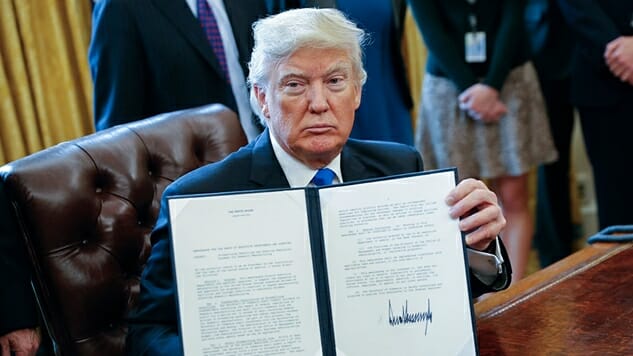Despite Trump’s Efforts, the Solar Industry Marches Forward with New Breakthroughs in Technology
Photo by Pool/Getty
New innovations in solar technology seem to arrive daily, and the beneficiaries of these breakthroughs are everyday businesses and consumers. What’s becoming most prominent across the solar landscape in recent months, however, is how new applications and technologies are disrupting the industry in the face of President Trump’s threatening stance on renewables at large.
Trump is in the opening stages dismantling the Clean Power Plan, an Obama-era energy efficiency initiative that benchmarked the retirement of coal plants. In fact, Trump is going one step further and actually reopening public lands to oil and gas extraction, in addition to greenlighting the completion of the controversial Keystone XL Pipeline. Needless to say, Trump’s substantial budget cuts to the Energy Department and the EPA seem pedestrian at this point, though their ramifications will be felt for years to come.
But the solar industry is proving resilient while stretched on the rack of federal constraints, and Americans are still seeing the many advantages of transitioning to renewables materialize in real time.
Going It Alone on Solar
The average person today is likely aware of the common solar buzzwords: solar panels, solar cars, climate change and maybe even Elon Musk. But there are a number of smaller-scale advancements currently under the radar that may soon be prevalent in cities across the United States, ones the federal government would have a hard time preventing.
Brooklyn Microgrid, for example, is a New York-based project that utilizes blockchain—the digital accounting and currency exchange system—for the purpose of activating consumers’ green energy transitions.
So how does it work?
Traditional energy consumption follows a strict supply chain involving electrical grids, power plants, utility companies, energy suppliers and various service providers that tack on additional fees and charges at each step of the process. In practice the only thing the customer cares about is being able to turn the lights off and on—everything else in the power chain is unknown for all intents and purposes.
But with Brooklyn Microgrid, residents with solar arrays on their rooftops opt into a peer-to-peer energy trading system that displaces utilities entirely. Say House A generates 110 percent of its electricity needs; what happens to the extra 10 percent it has on hand?
Some states mandate the method in which extra energy is sold back to utility companies in exchange for rebates on future electricity bills while others have no system in place for dealing with a transaction at all. For homeowners who don’t yet have battery storage devices installed on their properties, extra energy may be going to waste.
By using blockchain, Brooklyn Microgrid enables consumers to trade their excess energy on a private marketplace through a network of credits. House A can sell its extra energy credits to House B which may have only produced 90 percent of its electricity needs for a given month.
-

-

-

-

-

-

-

-

-

-

-

-

-

-

-

-

-

-

-

-

-

-

-

-

-

-

-

-

-

-

-

-

-

-

-

-

-

-

-

-








































